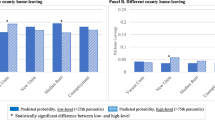Abstract
Using data from an experimental housing relocation program, this research compares social connections of children in families that move with those of similar children who do not move. Qualitative interview data are used to examine what factors influence the formation of social connections after moving. Results show the impact of moving on children's social connections is influenced by neighborhood context, financial resources, and children's age at the time of the move. Studies of moving during childhood need to pay closer attention to the factors that influence where, when, and why families move.
Similar content being viewed by others
References
Astone, Nan Marie, and Sara, S. McLanahan 1994 “Family structure, residential mobility, and school dropout.” Demography 31(4):575-584.
Boisjoly, Johanne, Greg, J. Duncan, and Sandra, Hofferth 1995 “Access to social capital.” Journal of Family Issues 16(5):609-631.
Briggs, Xavier de Souza 1998 “Brown kids in white suburbs: Housing mobility and the multiple faces of social capital.” Housing Policy Debate 9:177-221.
Census of Population and Housing 1990 Summary Tape File 3 on CD-ROM[machine-readable data files]/prepared by the Bureau of the Census. Washington: The Bureau [producer and distributor], 1992.
Coleman, James 1988 “Social capital in the creation of human capital.” American Journal of Sociology 94:S95-S120.
Federal Bureau of Investigation (FBI) 1996 Uniform Crime Reports for the United States (1995). Washington, DC: United States Department of Justice, Federal Bureau of Investigation.
Furstenberg, Frank Jr., 1993 “How families manage risk and opportunity in dangerous neighborhoods.” In William J. Wilson (ed.), Sociology and the Public Agenda: 231-258. Newbury Park, CA: Sage.
Furstenberg, Frank Jr., Thomas, Cook, Jacquelynne, Eccles, Glen, Elder Jr., and Arnold, Sameroff 1999 Managing to Make It: Urban Families and Adolescent Success. Chicago: University of Chicago Press.
Goering, John, Katherine, Carnevale, and Manual, Teodoro 1996 Expanding Housing Choices for HUD-Assisted Families. Washington, DC: U.S. Department of Housing and Urban Development.
Gramlich, Edward, Deborah, Laren, and Naomi, Sealand 1992 “Moving into and out of poor urban areas.” Journal of Policy Analysis and Management 11:273-287.
Hagan, John, Ross, MacMillan, and Blair, Wheaton 1996 “New kid in town: Social capital and the life course effects of family migration on children.” American Sociological Review 61:368-385.
Haveman, Robert, Barbara, Wolfe, and James, Spaulding 1991 “Childhood events and circumstances influencing high school completion.” Demography 28:133-157.
Hofferth, Sandra, Johanne, Boisjoly, and Greg, Duncan 1998“Parents' extrafamilial resources and children's school attainment.” Sociology of Education 71:246-248.
Humke, Christiane, and Charles, Schaefer 1995 “Relocation: A review of the effects of residential mobility on children and adolescents.” Psychology, A Journal of Human Behavior 32:16-24.
Ingersoll, Gary, James, Scamman, and Wayne, Eckerling 1989 “Geographic mobility and student achievement in an urban setting.” Educational Evaluation and PolicyAnalysis 11:193-199.
Jarrett, Robin 1997 “African American family and parenting strategies in impoverished neighborhoods.” Qualitative Sociology 20:275-288.
Jencks, Christopher, and Susan, E. Mayer 1990 “The social consequences of growing up in a poor neighborhood.” In Laurence, Lynn Jr. and Michael McGeary (eds.), Inner City Poverty in the United States: 111-186. Washington, DC: National Academy Press.
Los Angeles Police Department (LAPD) 1995 Selected Crimes and Attempts by Reporting District. Los Angeles, CA: Los Angeles Police Department [producer and distributor], 1996.
Massey, Douglas, Andrew, Gross, and Kumiko, Shibuya 1994 “Migration, segregation, and the geographic concentration of poverty.” American Sociological Review 59:425-445.
McLanahan, Sara, and Gary, Sandefur 1994 Growing Up With a Single Parent: What Hurts, What Helps. London: Harvard University Press.
Pribesh, Shana, and Douglas, B. Downey 1999 “Why are residential and school moves associated with poor school performance?” Demography 36:521-534.
Rosenbaum, James E., Nancy, Fishman, Alison, Brett, and Patricia, Meaden 1993 “Can the Kerner commission's housing strategy improve employment, education, and social integration for low-income blacks?” North Carolina Law Review Association 71:1519-1556.
Sampson, Robert, and Byron, Groves 1989 “Community structure and crime: Testing social-disorganization theory.” American Journal of Sociology 94:774-802.
South, Scott, and Kyle, Crowder 1997 “Escaping distressed neighborhoods: Individual, community, and metropolitan influences.” American Journal of Sociology 102:1040-1084.
South, Scott, and Kyle, Crowder 1998a “Leaving the 'hood: Residential mobility between black, white, and integrated neighborhoods.” American Sociological Review 63:17-26.
South, Scott, and Kyle, Crowder1998b “Housing discrimination and residential mobility: Impacts for blacks and whites.” Population Research and Policy Review 17:369-387.
Teachman, Jay, Kathleen, Paasch, and Karen, Carver 1996 “Social capital and dropping out of school early.” Journal of Marriage and the Family 58:773-783.
Teachman, Jay, Kathleen, Paasch, and Karen, Carver1997 “Social capital and the generation of human capital.” Social Forces 74:1343-1359.
Tucker, C. J., J., Marx, and L., Long 1998 “'Moving on': Residential mobility and children's school lives.” Sociology of Education 71:111-129.
Author information
Authors and Affiliations
Rights and permissions
About this article
Cite this article
Pettit, B. Moving and Children's Social Connections: Neighborhood Context and the Consequences of Moving for Low-Income Families. Sociological Forum 19, 285–311 (2004). https://doi.org/10.1023/B:SOFO.0000031983.93817.ff
Issue Date:
DOI: https://doi.org/10.1023/B:SOFO.0000031983.93817.ff



